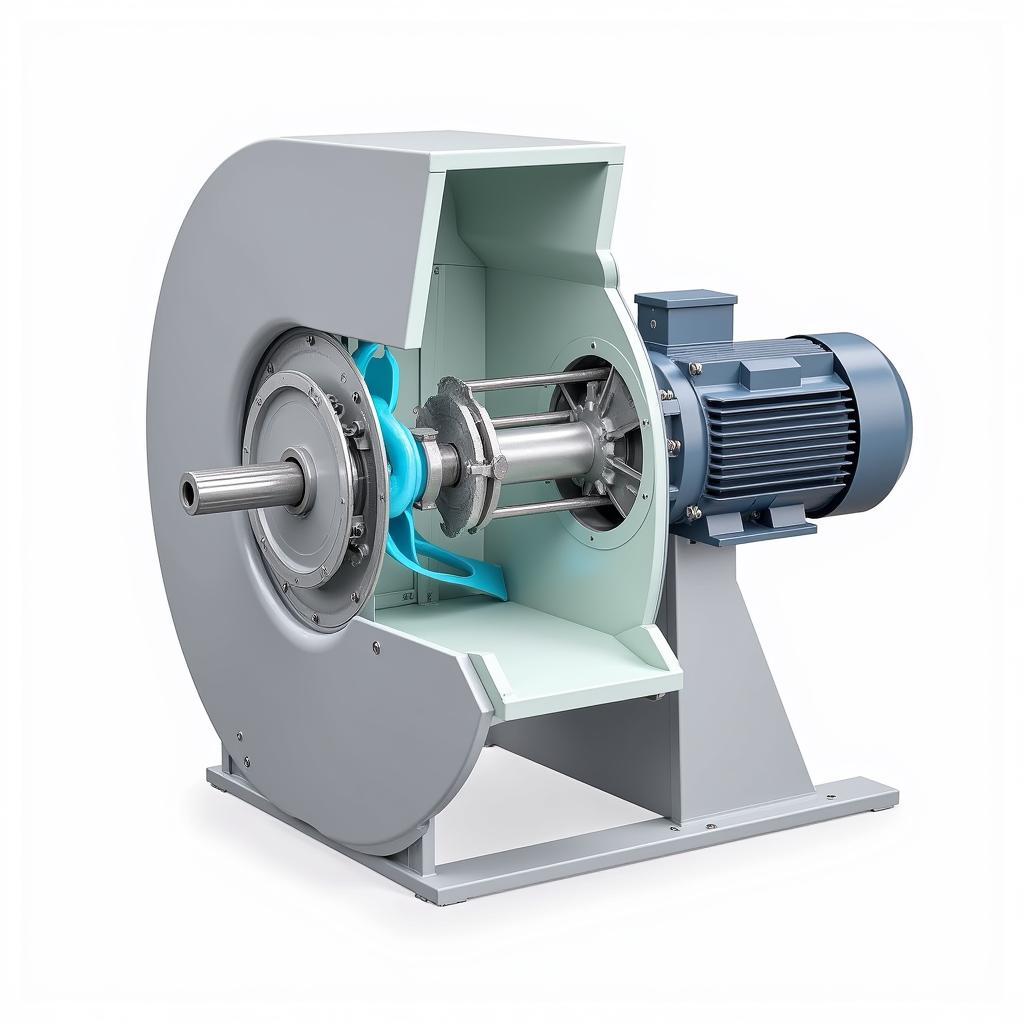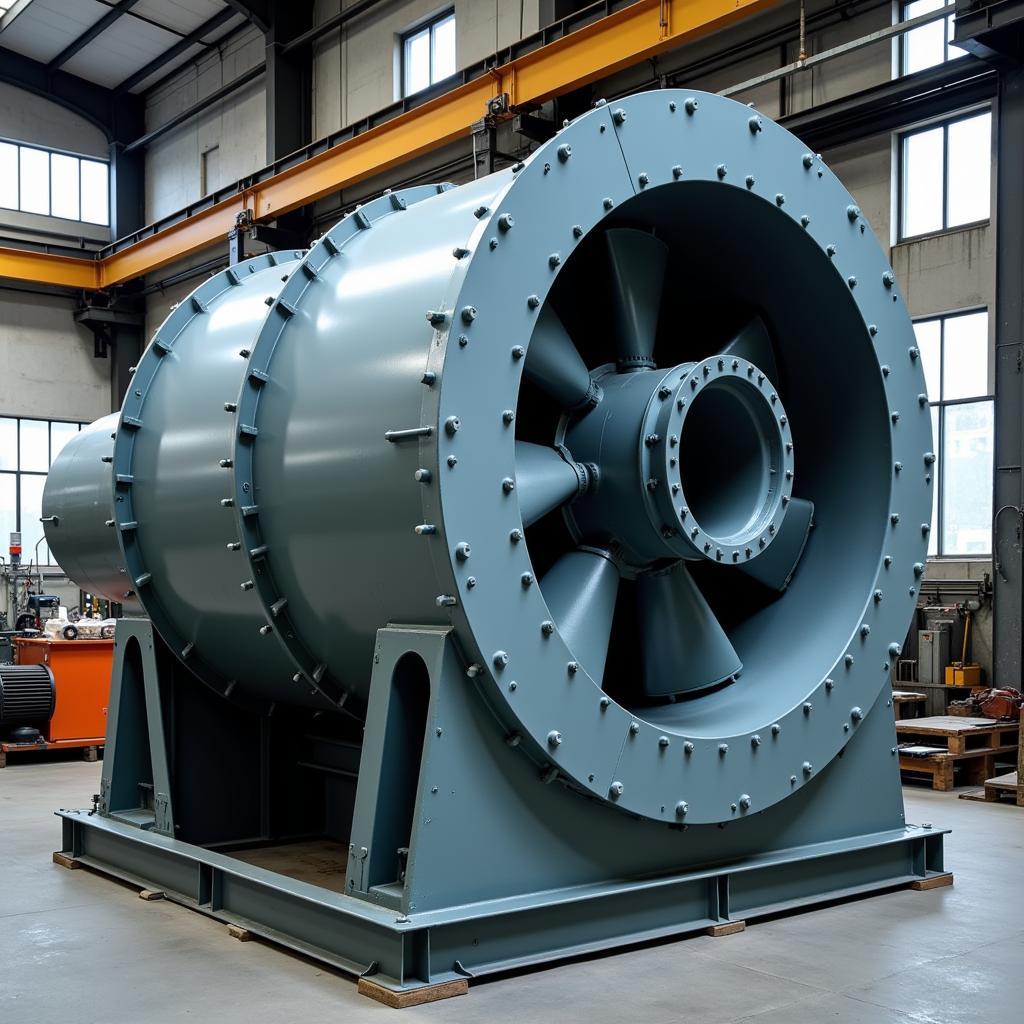Industrial Centrifugal Fans are the workhorses of ventilation, material handling, and various industrial processes. These robust machines use a rotating impeller to move air or gas radially, creating airflow and pressure crucial for numerous applications.
This comprehensive guide delves into the intricacies of industrial centrifugal fans, exploring their types, working principles, applications, and factors to consider for selection and maintenance.
Understanding Industrial Centrifugal Fans
Centrifugal fans, unlike axial fans that move air along a central axis, operate on the principle of centrifugal force. As the impeller rotates within a spirally shaped housing, it draws air or gas into the center and propels it outwards at a 90-degree angle. This action generates both airflow and static pressure, making centrifugal fans suitable for applications requiring higher pressure capabilities.
 Industrial Centrifugal Fan Components
Industrial Centrifugal Fan Components
Types of Industrial Centrifugal Fans
Industrial centrifugal fans come in various configurations to suit diverse needs. Some common types include:
- Forward Curved Fans: These fans are known for their quiet operation and high airflow at relatively low pressures. They’re ideal for applications like HVAC systems and air handling units.
- Backward Inclined Fans: Offering high efficiency and the ability to handle dust-laden air, backward inclined fans are commonly used in industrial settings for material handling and ventilation.
- Radial Blade Fans: Designed for high-pressure applications, radial blade fans are found in systems requiring significant air movement against resistance, such as dust collection and pneumatic conveying.
Applications Across Industries
The versatility of industrial centrifugal fans makes them indispensable across a wide range of industries:
- Manufacturing: From ventilation in factories to exhausting fumes and dust, these fans are crucial in maintaining a safe and productive work environment.
- Power Generation: Centrifugal fans play a critical role in cooling towers and boiler systems, ensuring efficient power plant operation.
- Mining: These fans provide essential ventilation in underground mines, removing hazardous gases and ensuring worker safety.
- Food Processing: From drying and cooling food products to exhausting odors and moisture, centrifugal fans are integral to hygiene and quality control in food processing facilities.
 Industrial Centrifugal Fan in Factory Setting
Industrial Centrifugal Fan in Factory Setting
Selecting the Right Industrial Centrifugal Fan
Choosing the appropriate centrifugal fan for a specific application involves considering several factors:
- Airflow Requirements: Determine the required airflow rate (cubic feet per minute or cubic meters per hour) to ensure adequate ventilation or material handling.
- Static Pressure: Calculate the system’s resistance to airflow (static pressure) to select a fan capable of overcoming it.
- Efficiency: Opt for energy-efficient fans to minimize operating costs, especially in continuous-duty applications.
- Noise Levels: Consider noise constraints in the installation environment, especially in noise-sensitive areas.
Maintenance and Troubleshooting
Proper maintenance is essential for maximizing the lifespan and performance of industrial centrifugal fans:
- Regular Inspections: Inspect fans for signs of wear and tear, including impeller damage, belt tension, and bearing lubrication.
- Cleaning: Regularly clean fan blades, housings, and inlets to prevent debris buildup that can hinder airflow and efficiency.
- Vibration Monitoring: Implement vibration monitoring to detect potential issues with bearings or impeller imbalance.
Conclusion
Industrial centrifugal fans are essential components in numerous industrial processes, providing reliable airflow and pressure for a wide range of applications. Understanding their types, working principles, and selection criteria is crucial for ensuring optimal performance, efficiency, and longevity in industrial settings. By prioritizing regular maintenance and addressing potential issues promptly, businesses can maximize their investment in these robust ventilation solutions.
FAQs
Q: What is the lifespan of an industrial centrifugal fan?
A: With proper maintenance, an industrial centrifugal fan can last for 15-20 years or more.
Q: What are the signs of a failing centrifugal fan?
A: Excessive noise, vibration, reduced airflow, and overheating are common signs of a failing fan.
Q: Can I adjust the speed of an industrial centrifugal fan?
A: Yes, the speed of most industrial centrifugal fans can be adjusted using variable frequency drives (VFDs).
Q: What safety precautions should be taken when working around centrifugal fans?
A: Always ensure the fan is de-energized and locked out before performing any maintenance or cleaning. Wear appropriate safety gear, including eye and ear protection.
For those seeking more specialized information, we offer resources on specific types of industrial fans, including commercial utility exhaust fans and commercial hvac ventilation fans in austin tx.
If you’re interested in acquiring a centrifugal blower fan pdf or need a centrifugal fan autocad drawing free download for your project, we provide valuable resources to assist you.
Need help selecting the right industrial centrifugal fan for your application? Contact our team at Phone Number: 0903426737, Email: fansbongda@gmail.com. Or visit us at Address: Hamlet 9, Ward 6, Gieng Day Ward, Ha Long City, Gieng Day, Ha Long, Quang Ninh, Vietnam. Our customer service team is available 24/7 to assist you.


